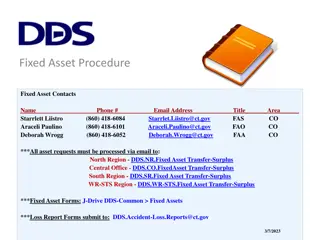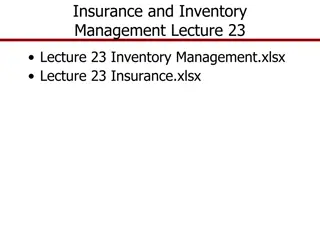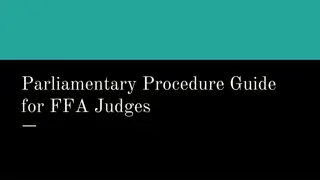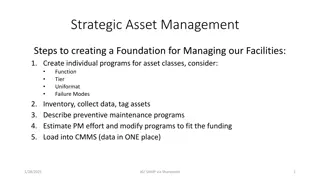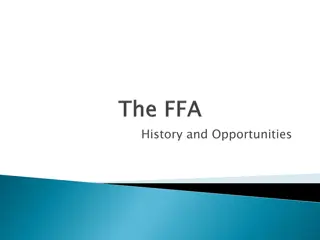Understanding Asset Share and FFA in Insurance Business
Delve into the intricacies of Asset Share and Fund for Future Appropriation (FFA) in the insurance sector. Explore concepts, implications, and regulations surrounding asset share, FFA, and expense management in participating life insurance businesses. Gain insights on surplus distribution, expense allocation, and compliance guidelines. Discover how actuaries play a crucial role in determining expenses and ensuring transparency in financial operations.
Download Presentation

Please find below an Image/Link to download the presentation.
The content on the website is provided AS IS for your information and personal use only. It may not be sold, licensed, or shared on other websites without obtaining consent from the author. Download presentation by click this link. If you encounter any issues during the download, it is possible that the publisher has removed the file from their server.
E N D
Presentation Transcript
34th India Fellowship Webinar Date: 23rd January 2021 Participating Business and FFA Guide : B N Rangarajan Presented By : 1. Ankit Sethi 2. Vishal Vermani 3. Pallavi Agarwal 4. K T Jayasager
Agenda Basic concepts : Asset share and Fund for Future Appropriation (FFA) Reasons & Implication of debiting priced acquisition expenses from asset share Expenses of Management and implication of higher than allowed expenses FFA in more details : Built up and Allocation Solvency management in declining FFA www.actuariesindia.org
Basic concepts : Asset share and Fund for Future Appropriation (FFA) www.actuariesindia.org
Asset Share is accumulation of : Premiums Investment Income Benefit Outgo Expenses Commission Shareholder Transfer Cost of Guarantee and Cost of Capital Taxes www.actuariesindia.org
Uses of Asset Share Surrender Value Calculation Bonus Declaration Reserving Maturity Value Calculation Death Value Calculation www.actuariesindia.org
FFA: excess of par assets over liabilities FFA Par Fund Assets Liabilities www.actuariesindia.org
Reasons & Implication of debiting priced acquisition expenses from asset share www.actuariesindia.org
Expense Related Relevant Regulations & Professional Guidance Guidance Note (GN)6 :Management of participating life insurance business with reference to distribution of surplus suggests expenses being charged to the asset share should be consistent to what has been illustrated to the policyholders Expenses of Management (EOM) regulations specifies maximum expenses that can be spent by a life insurance company in India, exemption conditions and actions for non-compliance requires insurers to have Board approved expense allocation policy. policy needs to be reviewed annually and primarily covers policy around which expenses to be allocated to various segments and basis/manner of allocation IRDAI (Non-Linked Insurance Products) Regulations 2019 Expenses charged to asset share shall be determined by the Appointed Actuary. Expenses charged to the With Profit fund and its appropriateness shall be disclosed to the With Profit Committee www.actuariesindia.org
Acquisition Expenses Charged to Asset Share Policyholder Reasonable Expectation Level of acquisition expenses should be known with greater certainty It would be unreasonable to charge higher acquisition expenses than provided in benefit illustrations given the timing of expense is just after the sale of the policy Charging higher than expected expenses could result in bad publicity Fairness of Treatment between different generation of Policyholder As asset share of older cohort of policyholders was debited by pricing acquisition expenses hence it would be unfair to charge actual (higher) acquisition expenses from the current or new policyholders www.actuariesindia.org
Acquisition Expenses Charged to Asset Share Market Practice If competitors are charging the pricing acquisition expenses from asset share then charging actual (higher) acquisition expenses from asset share may make the product unattractive to the potential customers Expense Overrun Initial Years of Operation In long-term, we expect our actual acquisition expenses to be in line with the pricing acquisition expenses due to the increase in business written Difference between this actual and pricing acquisition expenses is temporary and hence the funding of this differential expense is being done through FFA or by Shareholder This further helps us in maintaining a stable FFA year on year www.actuariesindia.org
Implications for debiting priced acquisition expenses from asset share Higher asset share means higher benefits to the policyholders Consistency with policyholder reasonable expectation Ensuring fairness across different generation of policyholders Lower expense loading than actual would enhance return to the policyholders leading to more new business coming on to books which may reduce the actual per policy expense loading Dependency on future new business to determine existing asset share www.actuariesindia.org
Implications for debiting priced acquisition expenses from asset share Overruns Funded through FFA Overruns Funded by Shareholder Reduction in FFA to the extent of overruns charged Reduction in Net worth to the extent of overruns charged Reduction in Solvency Ratio of Par business and hence the company Reduction in Solvency ratio of the company/non-par business due to reduction in net worth Depletion of FFA will start to limit risk appetite, investment strategy, smoothing capacity, bonus earning capacity Depletion of net worth will start to limit risk appetite, investment strategy and ability to write new business Losses to the shareholder to the extent of 10% given the FFA doesn t fall below a certain point www.actuariesindia.org
Expenses of Management and implication of higher than allowed expenses www.actuariesindia.org
Reasons for expenses being higher than allowed EOM regulations requires insurers to have Board approved expense allocation policy. Regulation also specifies - maximum expenses that can be spent by a life insurance company in India, - exemption conditions and action for non-compliance including charging expenses to Shareholder s Account, restriction on NB, removal of Managerial Personnel/Appointment of Administrator etc. Possible reasons for having higher than allowed expenses Initial years of operation High cost of operations High expense channel High proportion of single/ limited pay policies Low case size Lower than expected volume Capital expenditure/one-off costs www.actuariesindia.org
Importance of managing the expenses Higher than allowable expenses need to be represented to the regulator with business plan and time period required to bring expenses in line with the regulation Non-compliance can lead to severe consequences including restriction on opening of new branches and restriction on NB. Company needs to manage expenses well to avoid non-compliance actions Also, participating products can be part of product strategy and if managed well, can bring good value to the shareholders. It is, therefore, beneficial for the company too to make its participating product strategy work www.actuariesindia.org
Medium to long term implication of higher than allowed Expenses (1/2) Higher than allowed expenses will have direct impact on shareholder s profit as excess expenses are being reallocated to SH fund FFA may build up as excess expenses are being charged to SH. This FFA may have to be distributed to PH too. Higher than allowed expenses will impact solvency position of the company. New benefit illustration requires illustrations to be reviewed annually. The Company will be at competitive disadvantage if bonuses are revised down as a result of not managing the expenses well. Company might have to redraw its distribution channel strategy to reduce cost while considering impact on business and employees Need to consider if company s channel cost is higher than its competitors What can be done to reduce cost? Reduce overheads e.g. moving office to less expensive property, outsourcing Reduction in commission or other remuneration it might affect sale Are there too many layers? Move to/increase sale from less expensive channel e.g. Digital www.actuariesindia.org
Medium to long term implication of higher than allowed Expenses (2/2) Company might also have to rework its product strategy Increase case size of the policies Write longer term policies Write more products that have lower expenses Acq/maintenance commission split On the positive side, if insurer is new, it can be made a marketing point In the long run, it can be seen as lack of financial discipline by the company which can lead to bad press www.actuariesindia.org
FFA: Built up and Allocation www.actuariesindia.org
What is FFA? IRDAI (Preparation of Financial Statements and Auditor s Report of Insurance Companies) Regulations, 2002 defines FFA as The FFA shall represent all funds, the allocation of which, either to the policyholders or to the shareholders, has not been determined by the end of the financial year 1,900 15,264 In other words, FFA is excess of assets over statutory liabilities FFA Role of FFA Investment flexibility Facilitate smoothing Funding new business capital strain Improving solvency ratio Lower cost of reinsurance Cushion against adverse events Assets 13,364 Liabilities GN6 requires the Appointed Actuary to consider whether the surplus/deficit from various sources to form part of the asset shares or is maintained within FFA www.actuariesindia.org
FFA Built up (1/2) Depends on sources of surplus are distributed to PHs or maintained within FFA Deferral of Distribution of Surplus Declaration of terminal bonus rather than reversionary bonus will reduce guarantees and thereby reduce reserves Entire surplus may not be distributed. Some portion may be retained as a cushion for adverse events or for smoothing purpose Profits from surrendered policies Surrender benefit should represent asset share: IRDAI (Non-Linked Insurance Products) Regulations, 2019 Excess of asset share over surrender benefit is surrender profit Depends on bonus philosophy of the company Investment return earned Return earned on FFA itself contributes to growth in FFA www.actuariesindia.org
FFA Built up (2/2) Tax Credit Tax is payable on distributable surplus Tax may not be payable at the company level, due to past accumulated losses This saving contributes to FFA Profits not allocated to asset share Miscellaneous profits not allocated to the asset share, example rider profits Deductions from Asset share Cost of capital and cost of guarantees deducted from asset share Expense Overrun Acquisition expenses higher than those implicit in benefit illustration may be allocated to FFA Expense overrun can be funded by shareholders and not charged to FFA www.actuariesindia.org
Appropriate level of FFA There is no defined practice or Regulation describing an appropriate level of FFA Below points can be considered while determining level of FFA to be maintained: FFA is used for supporting solvency. Therefore, FFA can be maintained at a level which helps achieves the solvency target Company should not be over reliable on FFA for higher solvency Should not use FFA for solvency benefit at the cost of policyholder benefit PRE is created on declaration of stable bonus rates. Higher level of FFA needs to be maintained to sustain this PRE even in case of adverse events Higher FFA allows greater ability to take risks, e.g. investment strategy, level of reinsurance required etc. The desired level of risk appetite will guide in deciding the ideal level of FFA IRDAI Non-Linked Products Regulations, 2019 requires the Treatment of Fund for future appropriation to be included in the WPC report www.actuariesindia.org
Appropriate level of FFA Decision on ideal level of FFA is subjective and requires a lot of expertise and judgment of the management especially the Appointed Actuary Company needs to have a defined philosophy on the level of FFA to be maintained, e.g. defined level of FFA as a % of Par fund, FFA as a % of RSM etc. If there is excess FFA, it can be distributed directly or indirectly to policyholders Company may not want to allocate entire FFA except in case of winding up of the company or closure of participating fund to new business Any decision taken needs to maintain a balance between shareholder and policyholder needs www.actuariesindia.org
Methods of Allocation of FFA On reaching the threshold limit of FFA, it can be used to: Support a higher risk investment strategy Change the bonus or smoothing philosophy Reduce expenses charged to asset shares Offer product with high guarantees Sell a loss making product subject to Regulatory approval Transfer non-participating liabilities and backing assets out of participating fund subject to Regulatory approval, e.g. reduced paid-up policies liabilities These are the nature of indirect distributions. FFA can also be distributed in a more direct way by making: Enhancements to asset shares, and/or Additional regular or final bonuses www.actuariesindia.org
Desirable features of Allocation Consistent with Regulations and company s policy Approved by With Profits Committee and Board Applied consistently across all policyholders Straightforward to implement Easy to explain to policyholders Reflect the contribution made by policyholders to the built up of FFA www.actuariesindia.org
Factors to be considered Pace of distribution Distributed too quickly security of remaining policyholders might be at risk Distributed too slowly small number of remaining policies may receive high share of FFA distribution Equitable and fair distribution of surplus between different generations of policyholders IRDAI (Distribution of Surplus) Regulations, 2002 states that the shareholders shall be allocated 1/9th of the surplus allocated to the participating policyholders . Hence, any FFA distributed by way of bonus to PHs will result in increase in transfers to SH Supportable investment strategy Extent of smoothing possible on bonus distribution Solvency position after distribution of surplus www.actuariesindia.org
Solvency management in declining FFA www.actuariesindia.org
Solvency Management With Profits Governance- General Principles: meet the contractual obligations to the with-profits policyholders meet the solvency and capital adequacy as required by IRDAI treat policyholders fairly and meet the reasonable expectations of with-profits policyholders maximise the financial returns to the with-profits policyholders and shareholders www.actuariesindia.org
Solvency Management Solvency without FFA AA Should have regard to whether there is a significant increase in statutory/ realistic solvency (GN 6) What is the current and projected solvency positions with and without FFA? If the current and projected solvency without FFA is acceptable, allocation of FFA is not a concern Reserving: Is the Company allowing appropriate allowance for TB in reserves (IRDA ALSM Regulations)? Appropriate allowance for TB in reserves helps gradual increase in liability and thus protecting the solvency position against sudden pay-out of future terminal bonus www.actuariesindia.org
Declining Solvency- Courses of action Financial Projection and Stress Testing: Project future FFA considering all future cash-flows including future sales- this should be ongoing process, particularly in the current pandemic situation Stress test the emergence of future profits by changing the future experience under different scenarios Expenses, lapses, mortality, investment return, Sales Analyse the impact on future solvency position- this helps in identifying the issues early, so that corrective action can be taken well in advance www.actuariesindia.org
Declining Solvency- Courses of action Allocation of surplus: Treatment of FFA- is it in line with WPC Report ? (Prod. Reg. 2019) Treatment of FFA- is it in line with PPFM? Setting Bonus rates- Ratio of asset share to Maturity/ Surrender value should be within a specified range as per the bonus philosophy (GN 6) Is it possible to rationalise distribution E.g. Different rates for NB to reflect current interest rates If any particular item of Surplus/deficit do not belong to the Par Fund and should not be re-distributed to either the current/ future generations of policyholders, these items should be specifically identified (GN 6) Misc. Surplus from various sources including surrender profit- treatment should be in line with bonus philosophy/practices of the company (GN 6) www.actuariesindia.org
Declining Solvency- Courses of action Capital and expense management: In case solvency is threatened, new business strategy can be revised which will revise the need for surplus and capital Change in surplus distribution philosophy that will reduce the policyholder benefits. But changes should be gradual so that PRE is maintained- there are practical difficulties Change in Investment philosophy which will influence the investment returns assumed in asset share calculations- is it against With-profit governance principles? Financial Reinsurance- Restrictions under new accounting standards Capital injection- But there are constrains because of 90:10 gate- will the Board agrees this? Securitisation Expense allocation to Par fund - is it high ? www.actuariesindia.org
Thank You www.actuariesindia.org
Any questions??? www.actuariesindia.org




